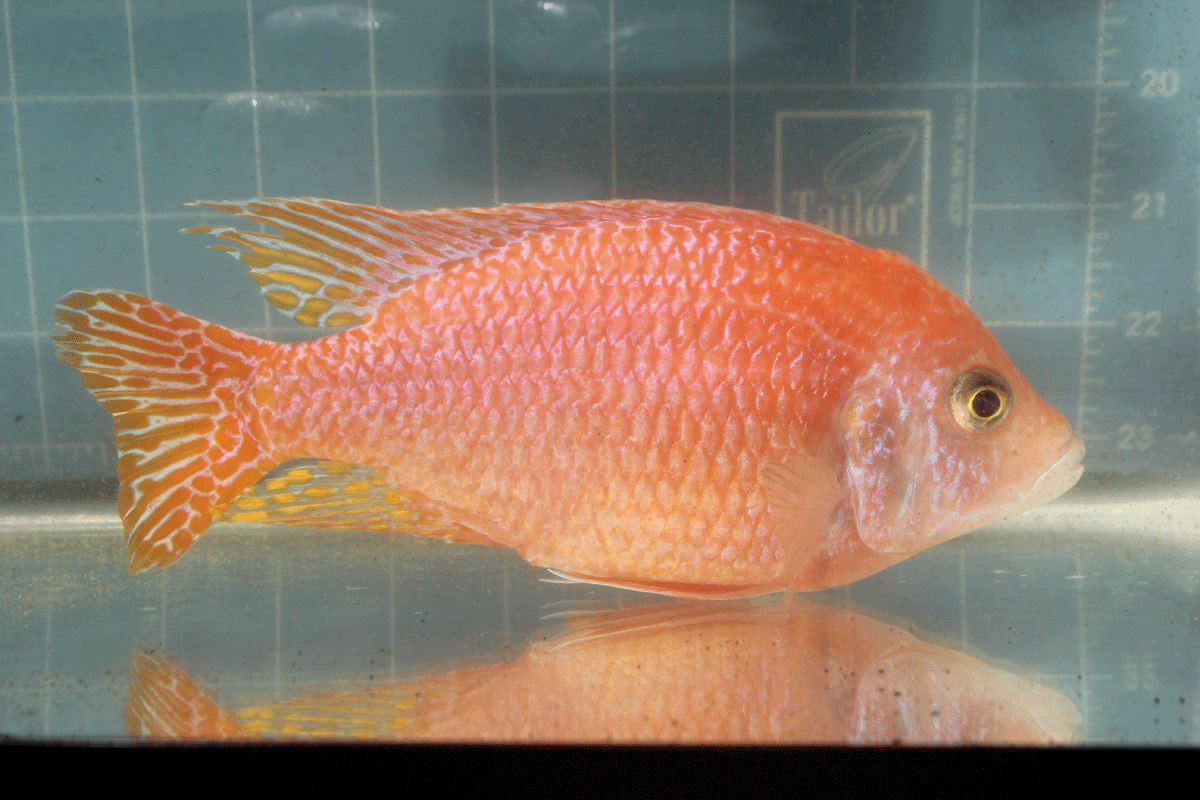Photo: A mature male Red Dragon Blood Peacock Cichlid.
A while back I set up a cross between a Red Dragon Blood Cichlid male and some Protomelas taeniolatus ‘Sunshine’ females. That’s him in the photo above. By the way, the grid behind him is in inches, showing how large he is. The Sunshine females were from a line of P. taeniolatus (Red Empress) that I started working on in November 2010. Since that time, I have selected these fish for gold-orange males (see photos of a male and a female from this strain below).


The purpose of this cross was to test my hypothesis about the genetics of the Dragon Blood color pattern. For some background on this fish and the development of my hypothesis, you might want to read the following blogs:
http://goliadfarms.com/dragon-blood-peacock/
http://goliadfarms.com/dragon-blood-peacock-cichlid/
http://goliadfarms.com/non-gold-dragon-blood-peacock/
To recap, my hypothesis was that the gold background color of the Dragon Blood Peacock is the result of a dominant gene (more properly “allele”, but I’ll stick with the popular usage of “gene”). If I was right, I expected one of two results from mating the male Dragon Blood to the P. taeniolatus females. One, all the offspring would be gold bodied because the male was 1) homozygous for the gold body color, meaning the male carried two copies of the gene for gold body color and 2) the gold body color resulted from a dominant gene. Second, about half the offspring would be gold bodied and the other half grey bodied because the male was 1) heterozygous, meaning he carried one copy of the gold gene and one for the normal grey color and 2) the gold body color was a dominant gene.
So, enough suspense! The matings resulted in…drum roll…46% gold bodied hybrid offspring. That’s close enough to 50% to mean the male was heterozygous and the gold bodied gene is dominant. Below are photos of young, about four month old males, the first a gold bodied male and the second a grey bodied male.


It will be interesting to watch these two hybrids mature. At this point, the grey fish looks much like a Protomelas taeniolatus of the same age. The gold male has an interesting orange/sky-blue checkered pattern.
It’s worth noting that I originally set aside the Dragon Blood male because he was sky-blue instead of his current color. As he matured he turned orange. That was a disappointment since I am working on developing a strain of Skyblue Dragon Bloods.
After seeing these hybrids, I’m thinking of setting this Dragon Blood male up with some female Protomelas fenestratus. That species grows much larger than P. taeniolatus. I wonder if I can grow some really giant Dragon Bloods. Don’t tell Susie, my wife and business manager, about this. She takes a dim view of my experiments. She expects each tank to generate revenues and profits. In fact, you should see the Excel spreadsheets and Quick-Books reports she uses to determine which strains of fish pay their way.


Leave a Reply